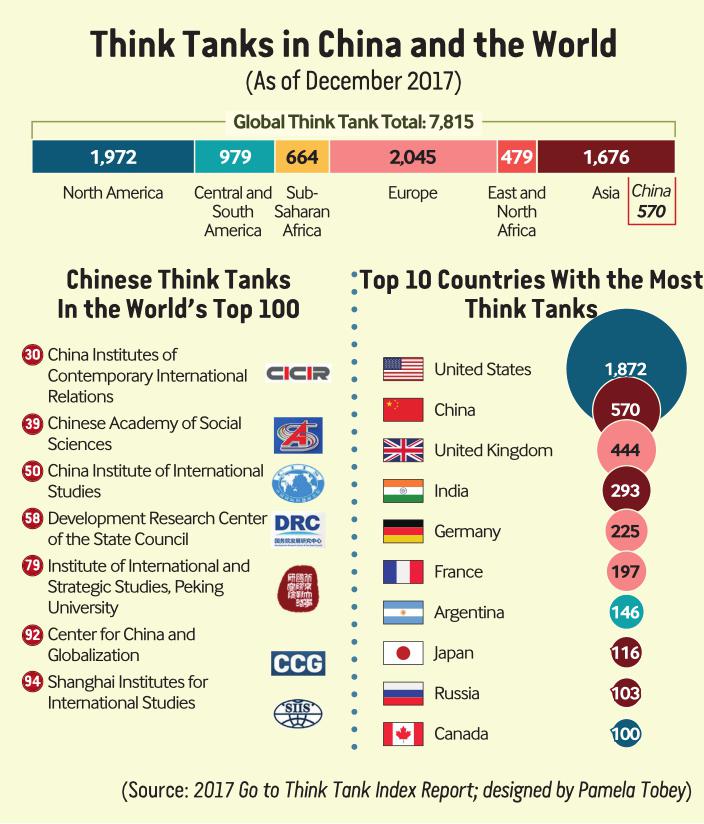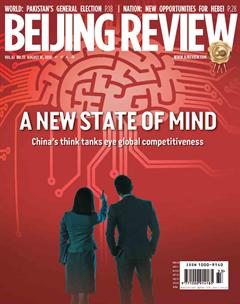THINKING ALOUD
By Li Nan


Its boom time for Chinese think tanks. With 570 such institutions, China maintains its eight-year dominance as the worlds second largest think-tank factory. A total of seven Chinese think tanks are on the global top 100 list, and almost 30 percent of the top 90 think tanks in China, India, Japan and the Republic of Korea are from China, according to the 2017 Go to Think Tank Index Report released early this year.
The report, undertaken by Professor James G. McGann and his team at the University of Pennsylvania in the United States, is an authoritative voice in international think tank circles and the 11th edition of its kind. When the report was first released in 2008, just 111 Chinese think tanks were included in the global pool.
“Thanks to the number of times Chinese President Xi Jinping has mentioned the importance of think tanks in advancing modernization and reform, endless public support is being provided for think tanks. It has created a golden age for think tanks in China,” McGann told Beijing Review.
New-style institutions
In a broad sense, the origins of Chinese think tanks can be traced back more than 2,000 years, when Lord Mengchang of the State of Qi recruited a 3,000-strong entourage to help him survive the chaos of the Warring States Period (453 B.C.-221 B.C.). However, the more direct ancestor of the modern Chinese think tank system emerged in 1949 with the founding of the Peoples Republic of China.
In 1949, the Chinese Academy of Sciences established a branch dedicated to philosophy and sociology—the embryonic phase of Chinas think tank system. Twenty-eight years later, in 1977, that embryo developed into Chinas first nationallevel think tank—the Chinese Academy of Social Sciences (CASS). The system was diversified over the following four decades, with a surge of government-affiliated and quasi-non-governmental think tanks from 1977 to 1987, the first batch of non-governmental institutions between 1988 and 1993, the emergence of those affiliated with universities from 1994 to 2002, and a new wave of non-governmental policy institutes from 2003 to 2012. During the last of those periods, 36 new non-governmental policy institutes were founded, nearly twice as many as those established by the government in the same time span.
Yet it was 2013 that marked a watershed moment in the development of the Chinese think tank. In April that year, President Xi first instructed on the construction of a new type of think tanks with Chinese characteristics. According to Xi, the more difficult reform and opening up becomes, the more powerful research institutes are needed. The think tank has since come to be viewed as a key tool in improving Chinas governance as well as an integral part of national soft power.
Two years later in early 2015, the Chinese Government rolled out a milestone document—the first of its kind since 1949—on how to build Chinese think tanks, aiming to develop a cluster of new institutions with Chinese characteristics including some world-renowned organizations by 2020.
So what exactly does a think tank with Chinese characteristics look like? Yu Yunquan, Deputy Director of the Academy of Contemporary China and World Studies(ACCWS), explained, “It should keep a close eye on Chinas reality, study China-related issues, and help to advance the countrys modernization.” ACCWS is a Beijing-based think tank which focuses on the study of international communication.
Last year, the most popular topics discussed by Chinese think tanks included the Belt and Road Initiative, BRICS, cooperation among East Asian countries, the Guangdong-Hong Kong-Macao Greater Bay Area, financial risk prevention, science and technological innovation, and Party building, according to the 2017 Chinese Think Tank Report released by the Shanghai Academy of Social Sciences in March.
In 2015, 25 think tanks, including CASS, were included among the first pilot units for building high-end policy institutes. They conduct research on hot topics concerning Chinas governance, public policy, macroeconomics and national security. They also engage in public diplomacy, trying to make Chinas voice better heard worldwide.
Non-governmental research organizations are also being taken into account.“The operation of a think tank with Chinese characteristics should be flexible and independent,” Yu told Beijing Review. This means that a think tank should present independent research. It should work for the common good of the whole country, society and the people, rather than for commercial benefi t or the interests of a specifi c department or a few people, he added.
Over the past 15 years, Chinas nongovernmental think tanks have grown by leaps and bounds, with some prestigious scholars and officials leaving their jobs to establish institutes of their own. Last year, 21 non-governmental policy institutes found a place on the domestic top 100 list according to the 2017 Chinese Think Tank Report, and many are playing a bigger role in Chinas governance.
The Center for China and Globalization(CCG), a Beijing-based think tank founded in 2008, is a prime example. The CCG is best known for its role in promoting the greater openness of China. In 2017, it ranked 92nd among top think tanks worldwide, and is the first non-governmental Chinese think tank ever to break into the top 100. One of the institutes cofounders, Wang Huiyao, was appointed a counselor to Chinas State Council by Premier Li Keqiang in 2015. The Central Government invites prestigious scholars, many of whom are either without party affi liation or aligned with non-Communist parties, to become counselors and offer advice on the countrys governance.
“It is safe to say that Chinas think tanks have grown rapidly in both quality and quantity,” Yu said.
Think tank diplomacy
Going global and enhancing exchanges with thinkers from around the world are goals shared by most Chinese think tanks, with many institutions exploring a multitude of ways to realize this objective. “In recent years, positive progress has been made in Chinese think tanks efforts to go global,”Wang Wen, Executive President of the Chongyang Institute for Financial Studies with Renmin University of China (RDCY), told Beijing Review.
Think tank forums have become a routine event on the sidelines of most international summits between China and its partners in recent years. In 2012, the China-Africa Think Tank Forum became a permanent feature of the Forum on China-Africa Cooperation, the paramount exchange mechanism between China and African countries. At the think tank forums seventh meeting, which took place in Beijing in early July, Chinas reform and opening up and the future of Sino-African ties were highlighted. Similarly in 2015 the largest ever Think 20 forum kicked off in Beijing with over 500 experts from think tanks and academic circles from the Group of 20 (G20) countries gathering to share views on the 2016 G20 Summit in China. Last year, the China Council for BRICS Think Tank Cooperation was established to further the exchange of knowledge among its fi ve member states.
Cohosting dialogue and seminars in for-eign countries on specific issues is another key way for Chinese think tanks to go global. One of the most impressive events was held in Washington, D.C. on July 5, 2016, a week before the ruling of the Philippines-initiated arbitration on disputes in the South China Sea was announced. Chinese and U.S. think tanks engaged in a comprehensive discussion on the South China Sea, urging all involved parties to deescalate the situation via a practical approach. “The dialogue attracted the international spotlight because of the views of former State Councilor Dai Bingguo, who stated that the so-called ‘arbitration award amounted to nothing more than a piece of paper,” said Wang of the RDCY.
Building foreign branches of domestic think tanks is another method employed by Chinese institutions. Chinas first overseas think tank—the Institute of China-America Studies—was established in Washington, D.C. in April 2015. Run by the Haikou-based National Institute for South China Sea Studies, the organization specializes in research on issues in the South China Sea and participates in related academic exchanges. Two years later, the China-CEE Institute, the first non-governmental Chinese think tank registered in Europe, was founded in Budapest, Hungary, aiming to encourage scholars in Central and Eastern European countries to carry out joint research, field studies and seminars with their Chinese peers. “It is a creative move in the history of Chinas think tanks,” Huang Ping, President of the China-CEE Institute told Peoples Daily.

Conversely, international think tanks are also partnering with their Chinese counterparts to establish branches in China. For example, the Brookings Institution, widely considered the worlds preeminent think tank, set up an overseas arm at Tsinghua University in Beijing in 2006.
Inviting foreign thinkers is another way to globalize Chinas think tank system. Many former international statespeople have become counselors or research fellows with Chinese think tanks, and the RDCY alone has more than 40 prestigious foreign thinkers, including former Slovenian President Danilo Türk.
By publishing articles and research in foreign languages and on overseas media platforms, think tanks are able to extend their global reach. Last summer, the English version of the 2017 Chinese Think Tank Report was released in London, the first report on Chinese policy institutes published overseas. Homegrown Chinese phrases such as the Belt and Road Initiative and a community with a shared future have also become buzzwords in international think tank circles.
“It is an undeniable fact that new Chinese think tanks have enhanced their international presence by taking some critical steps in the past five years,” Wang said.
Hurdles ahead
Despite evident progress, many industry experts believe there is a long way to go before Chinas think tanks can truly rival their international counterparts, with a lack of international talent the foremost challenge in this regard.
According to Wang, China has been able to attract some foreign experts, but this number is far from enough. He also believes a two-way flow of talent is required, meaning that China should both import and export thinkers at the same time. But China is still unable to provide a large pool of talent who can work for international organizations. “There are just a few Chinese thinkers who speak good English and can explain clearly the story of Chinas reform and opening up,” said Wang.
Wang suggests China build a global talent-recruiting mechanism to attract more foreign scholars to work at the countrys think tanks, while at the same time training more versatile domestic talent to be better acquainted with research and international communication.
A shortage of leading think tanks poses another barrier. China has the worlds second largest number of think tanks, but only 1.2 percent are considered among the worlds top 100, with none in the top 20.“Few Chinese scholars can make his or her voice heard by the world when discussing the same hotspot issue as Western thinkers. Even on some key Chinese issues, few domestic think tanks are able to put forward unique concepts or authoritative theories,”noted Yu, adding that working out how to deliver creative concepts is a common challenge facing all Chinese think tanks.
This further contributes to the trade deficit in intellectual output between China and the rest of the world. “Chinese wisdom seldom reaches foreign audiences. In the international trade of intellectual goods, China has a huge deficit with the world,”said Wang.
A limited capacity for international communication is also to blame. “Thanks to the overseas arms of think tanks and mediaaffiliated institutions, Chinese think tanks can now attract more of the international spotlight,” said Wang, while acknowledging that successfully integrating with local academic circles remains a problem.
McGann also highlights the pressure on think tanks to respond not only to questions about where society and government should go in the medium to long term, but also to what is happening on the street today. “Some of the institutions in China are too big and too bureaucratic to respond to these questions, even in the medium to long term,” he said.

